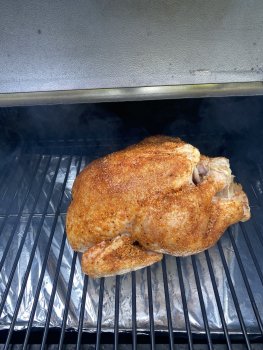Usually when you smoke you place a pan of water somewhere to regular the temps. Usually you want to smoke in the low 200s range. After a certain amount of time depending on your meat type and weight, you wrap it and place a little liquid in the bottom of your foil or butcher's paper, you wrap tightly and put it back in for an hour or two, and then for presentation you glaze and cook for 10-15 minutes to bake it onto it. Unless you had crazy high humidity or were eating Iberico ribs, you'll end up with tougher meat.
Good ribs should have a nice light bark, minimal sauce/glaze and should not be mushy. However, the bone should easily slide out with only two fingers with minimal wiggling. This is called a 3-2-1 method but you're better off going with probe temp, look and feel.
The same applies to brisket, pork shoulder, chicken (only needs a loose covering and no silly flipping), etc. While spare ribs have meat on the top and bottom side, the top side has the most. You can use stock, sauce, ACV/water, etc. and lay the top side down on that, wrap tightly and cook more. For this you'll want to come in periodically, unwrap and observe how it's coming along. Once you develop a bark, it won't get soggy.
You can do naked ribs, provided there's incredible marbling or connective tissue observed while you were preparing it. You need to remember that slow cooking or smoking meat is a Southern thing done way back when these were tough cuts and people sought a method to make them tender without cooking it with a bunch of vegetables or in broths. My usual recommendation is, the leaner the meat, the lower your smoke interior temp should be.
I smoked tri-tip a few weeks ago and I smoked at a 175-185* F until I hit an internal of 145* F. Usually you want two probes in addition to your hood temperature gauge. I used light woods like apple to give it a mild flavor. OTOH, you don't need to smoke food either. You can use lump charcoal in your grill and set a small fire to cook meat slowly. It's not different from slow cooking in an oven. This goes against direct grilling like they do in Santa Maria, where the meat is tougher and must be sliced very thin to be edible. Still good, but this is better.
When you slow cook food you're not rendering fat. Fat renders at a much lower temperature. You're breaking down collagen fibers between muscle fibers. You can slice up a pork shoulder and fry it up and it'll be tough as hell but if you slow roast, smoke, or cook it at a low temperature for 4-8 hours, you can shred the entire thing with gloved hands.
Pork loin also benefits from this cooking method. I usually inject mine with clarified butter and herbs, though. I skip the bacon wrap and go for a pasty covering with lots of coarse herbs and spices. You can cut an inch thick slice and eat it in a sandwich or "burger" and it'll be like butter.
Resting also matters. You can learn a lot from YouTube and forums. Unfortunately, neither were really around when I first began BBQ'ing. It was mail order magazines for the most part and a lot of trial and error.
Let's just say in those haydays when I began trying without much source material I often found myself whipping my then food processor out and pulverizing badly done meat into sandwich or filling material...
@Gutwrench can provide more info than I can. Hey smokes a lot of stuff whereas I don't due to time constraints unless it's a special event.
P.S. My decision on wrapping vs naked is highly dependent on what I see when I'm trimming up whatever I'm cooking. Most times a brisket will get wrapped because we don't often get very marbled brisket out here. That and I don't feel like spending 30 minutes wading through 400 lb of brisket at Costco.
[automerge]1594008725[/automerge]
I've often sat back amazed at how I can slow smoke a brisket for say 15-22 hours and then see it devoured in just about an hour. One the one hand it's bizarre on the other it makes me happy to see people eat it. Also the lack of leftovers makes sure I don't sneak in several midnight to daylight snacks...
Terrific and informative post.
From the perspective of our occasionally sodden, and wet and windy isles, the barbecue tradition can be somewhat alien; indeed, I confess to having harboured a bit of a prejudice against this method, as it seems to offer a refuge to a certain type of individual, intent on proving his masculinity, (yet never darkening the door of a kitchen otherwise).
Worse than the posturing, is the lamentable fact Our Barbecues seems to produce perfectly horrible food, meat that is tough, burnt, and worst of all, quite inedible, the sort that would require an implement with the strength of an electrical hedge trimmer to cut, and a task far beyond the ability of my poor teeth.
Actually, I have yet to eat meat from a barbecue that is edible - let alone tasty, but readily concede and admit that the method would not be so popular unless some culinary cultures had mastered it completely.
Nevertheless, reading this post makes me long for the soft-textured, tasty, barbecued meats described in loving detail in some of these amazing posts.


